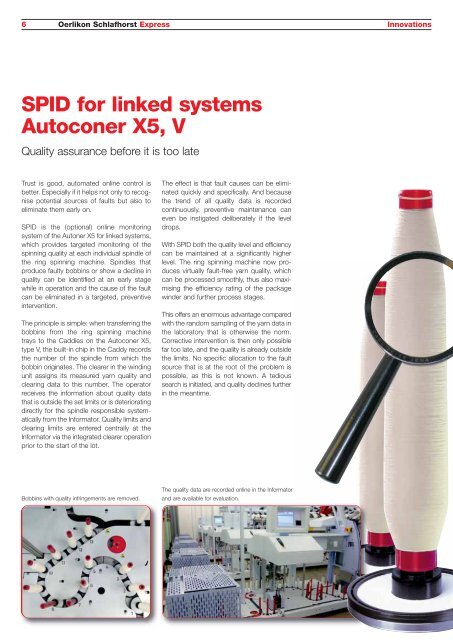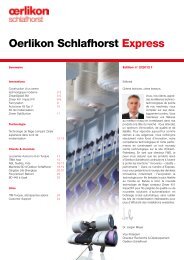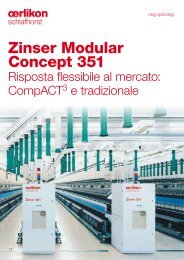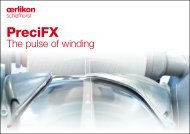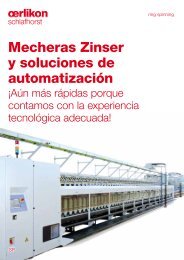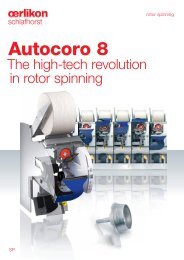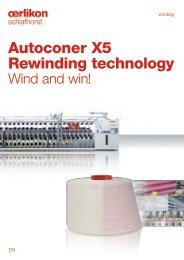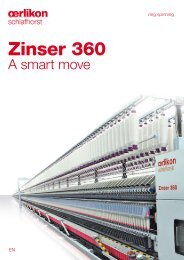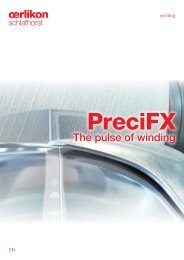Oerlikon Schlafhorst Express - Oerlikon Schlafhorst - Oerlikon Textile
Oerlikon Schlafhorst Express - Oerlikon Schlafhorst - Oerlikon Textile
Oerlikon Schlafhorst Express - Oerlikon Schlafhorst - Oerlikon Textile
Create successful ePaper yourself
Turn your PDF publications into a flip-book with our unique Google optimized e-Paper software.
6 <strong>Oerlikon</strong> <strong>Schlafhorst</strong> <strong>Express</strong><br />
Innovations<br />
SPID for linked systems<br />
Autoconer X5, V<br />
Quality assurance before it is too late<br />
Trust is good, automated online control is<br />
better. Especially if it helps not only to recognise<br />
potential sources of faults but also to<br />
eliminate them early on.<br />
SPID is the (optional) online monitoring<br />
system of the Autoner X5 for linked systems,<br />
which provides targeted monitoring of the<br />
spinning quality at each individual spindle of<br />
the ring spinning machine. Spindles that<br />
produce faulty bobbins or show a decline in<br />
quality can be identified at an early stage<br />
while in operation and the cause of the fault<br />
can be eliminated in a targeted, preventive<br />
intervention.<br />
The principle is simple: when transferring the<br />
bobbins from the ring spinning machine<br />
trays to the Caddies on the Autoconer X5,<br />
type V, the built-in chip in the Caddy records<br />
the number of the spindle from which the<br />
bobbin originates. The clearer in the winding<br />
unit assigns its measured yarn quality and<br />
clearing data to this number. The operator<br />
receives the information about quality data<br />
that is outside the set limits or is deteriorating<br />
directly for the spindle responsible systematically<br />
from the Informator. Quality limits and<br />
clearing limits are entered centrally at the<br />
Informator via the integrated clearer operation<br />
prior to the start of the lot.<br />
Bobbins with quality infringements are removed.<br />
The effect is that fault causes can be eliminated<br />
quickly and specifically. And because<br />
the trend of all quality data is recorded<br />
continuously, preventive maintenance can<br />
even be instigated deliberately if the level<br />
drops.<br />
With SPID both the quality level and efficiency<br />
can be maintained at a significantly higher<br />
level. The ring spinning machine now produces<br />
virtually fault-free yarn quality, which<br />
can be processed smoothly, thus also maximising<br />
the efficiency rating of the package<br />
winder and further process stages.<br />
This offers an enormous advantage compared<br />
with the random sampling of the yarn data in<br />
the laboratory that is otherwise the norm.<br />
Corrective intervention is then only possible<br />
far too late, and the quality is already outside<br />
the limits. No specific allocation to the fault<br />
source that is at the root of the problem is<br />
possible, as this is not known. A tedious<br />
search is initiated, and quality declines further<br />
in the meantime.<br />
The quality data are recorded online in the Informator<br />
and are available for evaluation.


